
Silk Road Trade & Travel Encyclopedia
丝绸之路网站(丝路网站)
丝绸之路百科全书—游客、学生和教师的参考资源
İPEK YOLU
ve YOLLARI
ANSİKLOPEDİSİ
www.ipekyollari.net
A
A B
C
D
E
F
G
H I
J
K
L
M
N O P
Q
R
S
T
U V
W
X
Y
Z
Abbasid Dynasty
(750-1258) builds their capital in
Baghdad, making this Silk Road city a center of power where philosophic,
scientific and literary works are cultivated.
The
Abbasid Dynasty was the third of
the Islamic
caliphates and was founded in
Harran in 750
by the descendants of Prophet Muhammad's youngest uncle, Abbas ibn Abd al-Muttalib.
From Haran the capital shifted in 762 to
Baghdad,
which grew under the Abbasids for two centuries. Previously, during the reign of
the Umayyad caliph Marwan II, Harran had become the seat of the caliphate
government of the Islamic empire which stretched from Spain to Central Asia.
During the late 8th and 9th centuries, the city of Harran was also a center of
learning where translating works of astronomy, philosophy, natural sciences, and
medicine from Greek to Arabic brought an exchange of knowledge between the
classical and
Islamic worlds.
Achaemenid Empire (c. 550–330 BCE), also known as the Persian Empire,
was the largest empire by geographical extent in
ancient times; at the height of its power, the empire spanned three
continents: Asia, Africa and Europe. The empire was forged by
Cyrus the Great. At its greatest extent, the empire included the modern
territories of Iran,
Afghanistan,
Pakistan,
parts of
Central
Asia,
Asia Minor,
Thrace and
Macedonia, much of the
Black Sea
coastal regions, Iraq,
northern
Saudi
Arabia, Jordan,
Israel,
Lebanon,
Syria, and all
significant population centers of
ancient Egypt as far west as
Libya.
African Trade Routes For much of history, Africa was regarded by
Europe as the “Dark Continent,” because so little was known about it. Yet, for
millennia, African routes existed overland, by river, and by sea. Between
3000-1000 BCE, the first extensive trade routes were developed upon the great
rivers which become the backbones of early civilizations - the Nile in Africa,
the Tigris and Euphrates in the Near East, and the Yellow River and the Indus in
Asia (historically, the period from 1250 BCE–153 CE saw the Mediterranean,
Western Asian, Chinese and Indian societies develop major transportation
networks for trade). But it was in the eastern Mediterranean where extensive maritime trade
first developed -- first between Egypt and
Minoan Crete
(c.3000-1000 BCE) -- and later with
Phoenician ships throughout the Mediterranean and along the north African coast.
(See Carthage / Saharan Trade)
More...
Afrosiab The name for ancient Samarkand, often called
"the Heart of the
Silk Road," now in modern-day
Uzbekistan. One of the great archaeological finds of the 20th century, Ulugh Beg's
observatory, built in the 1420's, is located here. The city
is included in the
UNESCO
World Heritage List.
Age of Discovery (also known as the European "Age
of Exploration") was a period which began with 16th century geographic
exploration, leading to European overseas expansion and the rise of
colonial empires. In the late Middle Ages,
transcontinental trade along the Silk Routes declined, as sea routes increased
and maritime trade developed.
More...
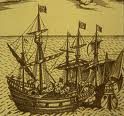
In search for the passage to India
and beyond, Europeans sought to sail eastward from Europe, to fabulous Cathay
(China), and the mysterious island of Cipango (Japan). The desire to trade
directly with China was the main motive behind the expansion of the
Portuguese Empire beyond Africa after 1480, followed by the expansion of the
Dutch and British colonial empires.
Ahmedabad was founded in 1411 by Sultan Ahmed Shah on the banks of the
river Sabarmati. Later, the Royal City of Ahmedabad became the commercial and
cultural capital of Gujarat. When the Mughal Empire annexed Gujarat in 1572,
Ahmedabad lost its political pre-eminence, but continued to flourish as a great
trading centre connecting the silk route with the
spice route. Through the
centuries Ahmedabad remains a prosperous city, as it is India’s seventh largest
city, and is also one of the subcontinent’s few medieval cities which continues
to prosper. More...
Ak Han Kervansaray is a typical example of Seljuk Caravanserai
architecture. It is located near Denizli along the Silk Routes of Turkey. The
Seljuk Islamic decorative motifs include an ornate front portal that includes
flowers, leaves, and doves as part of its stone sculpture decoration. A tower
stands at each end of the main entrance hall, serving as a lookout towers. The
13th century Caravanserai was built on a flat plain that allowed travelers,
enemies or robbers to be seen from a considerable distance.
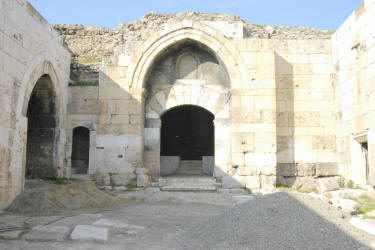
Ak Han Kervansaray, Turkey built c.
1253-1254
Akbar
Jalaluddin Muhammad Akbar (1542 –
1605) the third
Mughal Emperor. He was of
Timurid descent; the son of
Humayun,
and the grandson of
Babur,
the ruler who founded the Mughal Empire in India. At the end of his
reign in 1605, the Mughal Empire covered most of the northern and central
India and was one of the most powerful empires of its age.
The
Silk Road brought trade and
prosperity to northern India.
Akbar's reign significantly influenced art and culture in India
and the region.
Under the
The
Mughal Emperors
and the Islamic
Dynasties of
India, the city of
Agra became a leading center of art, science, commerce, and culture.
More...
Aksu (Akesu) is a city in northwest China's Xinjiang Uygur autonomous region.
It was an important stop on the
Northern Silk Road that runs along the northern edge of the
Taklamakan desert in the
Tarim
Basin between
Kucha and
Kashgar. Aksu was positioned on a junction of trade routes: the northern-Tarim
route of the
Silk road, and the dangerous route north via the
Tian Shan's
Muzart Pass to the fertile
Ili River
valley. Aksu Prefecture shares a boundary to the northwest with Kazakhstan and
Kyrgyzstan. In the south, it is separated from Hotan by the Taklamakan Desert.
It is northeast of Kashgar. Aksu lies at the south foot of Tianshan Mountain on
the north edge of the Tarim Basin. The Tianshan Mountains are in the north while
the Taklamakan Desert lies to the south.
Aksum (Axum) Much of of the wealth of Axum derived from its control of
the Incense trade. The Ethiopian Kingdom of Aksum challenged Rome's monopoly of
Eastern trade by way of the Red Sea. With the economic decline of the Roman
Empire during the 3rd century, Greco-Roman trade in the Indian Ocean declined.
Thanks to the eastern provinces of the Roman Empire, the demand for Oriental
goods prospered under the Byzantines, whose capital Constantinople, now
Istanbul, replaced Rome as the the leading city in Europe. Greco-Roman commerce
with India reached its peak during the reigns of the Julio-Claudian and Flavian
emperors, 31-96 AD. More...
Aksumite Kingdom (or Axumite Empire) was an
important trading nation in northeastern Africa (modern Ethiopia), which achieved prominence by
the 1st century AD. The Aksumite Kingdom and other civilizations of
Eurasia were involved in various commercial activities, such as the
spice trade, since
ancient times.
More...
Ala Shan a desert in Central Asia, in northern China,
between the Ala Shan Range (Heilungkiang) and the Hwang Ho River in the east,
the Jo Shui (Etsin Gol) River in the west, the foothills of the Nan Shan in the
south, and the Gobi tectonic depression at the border between China and Mongolia
in the north. It has an area of about one million sq km. The altitude ranges
between 820 m in the northwest to 1,660 m in the south. The Ala Shan is a
stratified plain with small isolated ranges of a relative altitude of 150–200 m
(Bayan Ula, Hara Ula, and others) and areas of low rounded hills. There are
numerous closed depressions with fresh or salt subsoil waters not far from the
surface and salt lakes that are sometimes dried out (Hara Nur, Zhalatai Daws).
There are large tracts of moving sands: in the southwest, Badan Zhareng; in the
south, Kholalis; in the southeast, Tengri; and in the northwest, Ulanpukho. The
Badan Zhareng tract has the largest sand ridges, attaining heights of 300–400 m.
The river system is rich in seasonal streams, which flow only in the
summer—during monsoon or other heavy rains. The biggest rivers are the Jo Shui
and Shuihe. There are many lakes but most of them are very small, except the
Sogo Nur and Shara Burdu lakes.
Alaqa-Beki Daughter of Genghis
Khan who by the 1220's was a major figure in
Mongol China representing Onggud.
Al-Athir (1160 -1233) An
Arab historian whose works are extremely important for the early years of Mongol
expansion to 1231.
Aldaulat
Sa'd Aldaulat of Abar Jewish physician
and vizier to Ilqan Arghun during the 13th century.
Aleppo
(Hallab) was a large
trading city, like Hamidiye, located in Syria at the western end of the Silk
Road. Equidistant from the Mediterranean and the Euphrates, Aleppo rivals
Damascus in its claim as the oldest continuously inhabited city in the
world. After Islamic rulers conquered it, in A.D. 636, Aleppo succeeded
Antioch as the most important Western destination for Silk Road
caravans. The city’s souk (market) still occupies
its original Silk Road site.
More...
Alexander the Great (born c. 356 BC) The expansion of
Alexander the Great's empire into
Central Asia contributes to opening the Silk Road between the East and West. Alexander III of Macedon, commonly known as Alexander the Great, was a king of Macedon or Macedonia.
By the age of thirty he was the
creator of one of the largest empires in ancient history, stretching from the
Ionian sea to the Himalaya. He is considered one of
the most successful commanders of all time. Alexander was tutored by the famed
philosopher Aristotle. In 336 BCE he succeeded his father Philip II of Macedon to
the throne after he was assassinated. The
Macedonian Empire stretched from the
Adriatic sea to the Indus
River. Following his desire to reach the "ends of the world and the Great
Outer Sea," he
invaded India in 326 BC, but was eventually forced to turn back.
It was after Alexander's Balkan
campaign in Europe that Alexander crossed into Asia where in 334 BC the
Battle of the Granicus River was fought in Northwestern Asia Minor
near the site of Troy in modern-day Turkey. He conquered Asia Minor, Syria,
Phoenicia, Egypt, and Iran. After Alexander defeated the last of the
Achaemenid Empire's forces in 328 BC, he began a new campaign against the
various Indian kings in 327 BC. Crossing through the Amudarya, in the summer of 327, he passed through
the Hindukush and began his famous
Indian campaign. Alexander's goal was to conquer the entire "known
world," which in Alexander's day, ended on the eastern end of India. In
August 329 BCE, at the mouth of the Fergana Valley in Tajikistan Alexander founded the city of
Alexandria Eschate or "Alexandria The Furthest."
This later became a major staging point on the northern Silk Route.
More...
Altai Mountains are a
mountain range in central
Asia, where Russia,
China, Mongolia and Kazakhstan come together, and where the
rivers Irtysh and
Ob have their sources. The Altai Mountains are known as the original locus of
the speakers of
Turkic as well as other members of the
Altaic language group.
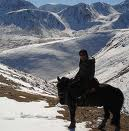
Alma Ata (Almaty) The largest city in
Kazakhstan
(it was also the capital until 1997 when Astana was made the capital of
Kazakhstan). In 10–14th
centuries, the area was a popular destination as part of the trade routes of the
Silk Road.
At that time, Almaty became one of the trade, craft and agricultural centers on
the Silk Road
and possessed an official
mint.
The city was first mentioned as Almatu in books from the 13th century.
After the 15th–18th centuries, trade activity decreased on this part of
the Silk Road.
Amazons are a nation of all-female warriors in classical and
Greek mythology. Herodotus (5th century BC, born in Halicarnassus modern day
Bodrum, Turkey). placed them in a region bordering Scythia in Sarmatia (modern
territory of Ukraine), while other historiographers place them in Asia Minor or
India.
Amber Road was an ancient
European
trade route for the transfer of
amber. As
one of the waterways and ancient highways, for centuries the road led
from Europe
to Asia and
back, and from northern Africa to the
Mediterranean Sea. An important raw material, amber was transported
from the
North
Sea and
Baltic Sea coasts overland by way of the
Vistula
and
Dnieper rivers to
Italy,
Greece,
the
Black Sea, and
Egypt
thousands of years ago. In
Roman times, a main route ran south from the Baltic coast in
Prussia through the land of the Boii
(modern
Czech Republic and
Slovakia) to the head of the
Adriatic Sea. The Egyptian pharaoh
Tutankhamun had Baltic amber among his burial goods, and amber was sent from the North Sea to the
temple of
Apollo at
Delphi
as an offering. From the
Black
Sea, trade could continue to Asia along the
Silk
Road, and network of ancient trade route.
Amu Darya (Oxus) River is a major river in
Central
Asia. It is one of the two major rivers running into the Aral Sea. A
substantial part of the irrigated agriculture and civilization of western
Turkistan was located along this region. The river's total length is 2,400 kilometers (1,500 mi).
More...
Anatolia (Asia Minor, modern-day Turkey)
The
Silk Road between China and Europe ran right
through Anatolia.
Some Caravans proceeded to Europe
through the Thrace region (the territory of Turkey which rests in Europe).
There are many "Kervansaray's," found throughout Anatolia,
which served as major stopover points
of the Silk Road. Beginning in Anatolia, Alexander the Great swept
across the Persian empire and beyond to conquer a territory that stretched from
“Gibralter to Punjab.” Although his empire did not last beyond his death, in 323
B.C., Alexander the Great’s influence is evident in Central Asia’s Hellenistic
Buddha statues.
More...
Andalusia This region of Spain is south of the
Iberian peninsula and is divided into eight provinces:
Huelva,
Seville,
Cádiz,
Córdoba,
Málaga,
Jaén,
Granada and
Almería. The name Andalusia traces back to the
Arabic language
Al-Andalus. As well as
Muslim or "Moorish"
influences, the region's history and culture have been influenced by the earlier
Iberians,
Carthaginians, Greeks,
Roman Empire,
Vandals,
Visigoths, all of whom
preceded the Muslims, who ruled from 711 to 1492. The geostrategic position of
Andalusia in the extreme south of
Europe, together with Morocco
provided a gateway between Europe and Africa. In addition to
Andalusia's position between the
Atlantic Ocean and the
Mediterranean Sea,
Andalusia has figured prominently in the history of Europe and the Mediterranean
due to its links to the
trade routes between
Europe and North Africa.
Berber traders played a vital role. (See
Saharan Trade Routes)
More...
Andrew of Perugia
Franciscan bishop of Zaiton or Quanzhou, in Fujian, during the early 14th
century.
Animism refers to the belief that non-human entities are spiritual
beings, or at least embody some kind of life-principle. Animistic beliefs were
widespread in Central Asia, and exist today.
More...
Antioch (Antakya) Under the Romans, the Silk Road ended at Antioch, the final destination for
caravans coming from the west, and the last stop for good traveling to Rome. The
city is located north of Palmyra and Damascus.
Anxi (Guazhou) is located between Jiayuguan and Dunhuang in China. The
Yulin Grottoes and the ruins of the ancient city of Suoyang are located nearby.
Anxi (Parthia, or Arsacid Empire) The merchants of Anxi monopolized
the trade between China and Rome c. 100.AD. Anxi was a key transit station on
the Silk Road, also known as the
Arsacid territories. The Parthian Empire (247 BC – 224 AD) was a major
Iranian political and cultural power in the
Ancient Near East. It was founded in the
mid-3rd century BC by
Arsaces I of Parthia. The empire, located on the
Silk Road
between the
Roman
Empire in the
Mediterranean Basin and the
Han
Dynasty in China,
became a center of trade and commerce. In 97 AD, in order to establish trade
relations with Rome directly, China sent a military ambassador, Gan Ying, to
cultivate relations with the Roman Empire. However, because the merchants of
Anxi monopolized the trade between China and Rome and profited by selling
Chinese silk to Romans at very high prices, the Anxi merchants exaggerated the
hardships of crossing the sea and persuaded Gan Ying to give up his travel. As a
result Gan Ying returned to China. He brought back reliable and detailed
information about Central Asia and is known in historical records as the first
Chinese who went the furthest west during antiquity.
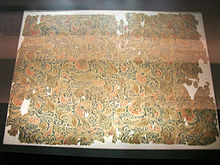
Chinese silk from Mawangdui, 2nd century BC, Han Dynasty.
Silk from China was perhaps the most lucrative luxury item the Parthians traded
at the western end of the Silk Road.
Apak Hoja Tomb in Kashgar, Xinjiang was built around
1640 for Yusuf Hoja, the father of Apak Hoja, who was a well-known sage
and teacher of a branch of Sufism. Apak Hoja died in 1693. Many
generations of their descendants have also been buried here.
The tomb consists of buildings that include the dome
shaped Tomb Hall, a Teaching Hall, the Great Hall of Prayer, and the
gate tower.
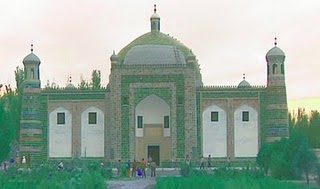
Arabia Many kingdoms emerged in southern Arabia based on the
monopoly of two prized goods of ancient times: frankincense and myrrh. These two
resins only grow in eastern Yemen and southern Oman and in some parts of
Somalia. Important trade routes, known collectively as the "Incense Route" were
mostly controlled by the Arabs, who brought frankincense and myrrh by camel
caravan from South Arabia. The incense trade flourished from South Arabia to the
Mediterranean between roughly the 3rd century BCE to the 2nd century CE. The
kingdoms included the: Saba kingdom, c. 950 BC–3rd
century AD; Ma'in kingdom, c. 4th–2nd century
BC; Qataban kingdom, c. 4th–1st century BC; Hadhramaut kingdom, c. 4th
century BC–3rd century AD; and the Himyar kingdom,
c. 2nd century BC–6th century AD.
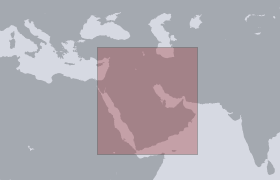
Aral Sea Large semi-saline sea in Central Asia which is fed by the
Amu-Darya and Syr-Darya Rivers.
Architecture of Central Asia has been influenced by a diverse array of
architectural traditions such as
Russian architecture during the eras of tsarist and Soviet rule,
Islamic architecture which came earlier,
Persian architecture, and
Chinese architecture.
More...
Ascelinus and Simon of San Quentin Dominican envoys of the Pope to
the Mongols (1245-1248), who went from the Levant into the southern Caucasus and returned
(accompanied by Mongol envoys) via Tabriz, Mosul, Aleppo, Antioch and Acre.
There is information about the embassy in Matthew Paris's chronicle as well as
in an account written by Simon of San Quentin.
Ashgabat The capital of
Turkmenistan,
and the ancient capital of the Parthian Empire, located near Nisa among the ruins of the
Silk Road. The city arose from the ruins of the
Silk Road
city of Konjikala, which was known as a wine-producing village in 2nd
century BCE, and was leveled by an earthquake in 1st century BCE. Konjikala was
rebuilt because of its advantageous location on the Silk Road and it flourished
until the invasion of the Mongols in the 13th century CE.
More...
Astana-Karakhoja Ancient Tombs are part of the underground museum of
Turpan, and are considered the living archives of Gaochang. Astana means capital
in Uyghur. Karakhoja is the name of a legendary hero of the ancient Uygur
Kingdom who protected his people from evil by killing a vicious dragon. The
tombs are located 42 km southeast of Turpan city and 6 km from the Ancient City
of Gaochang. The tombs and area served as the cemetery of the ancient Gaochang
residents, both aristocrats and commoners. Among the excavated 456 tombs, the
Gaochang king's tomb has not yet been found.
Astrakhan A Russian Silk Road city located north of the Caspian Sea. After 565 AD, Turkic
groups who had started to expand their empire formed their own direct trade
route to the north allowing goods to pass via the Caspian Sea to Baku or
Astrakhan, and on towards the Black Sea and the Caucasus. The Kazakhs became so
powerful during this period that they effectively controlled the Caspian Sea
trade. Merchants therefore had a choice of routes which seriously challenged the
Persian role as middlemen. The name Astrakhan, once a capitol of the Golden
Horde, began to appear in texts as Xacitarxan in the 13th
Century. In 1395 the city was sacked by Timur, but it was reborn as
an important city along the northern branches of the Silk Road and the capitol
of the Astrakhan Khanate between 1459 and 1556.
Astrolabe An astrolabe is a historical astronomical instrument
used by astronomers, navigators, and astrologers. Its many uses include locating
and predicting the positions of the Sun, Moon, planets, and stars; determining
local time; surveying; triangulation; and to cast horoscopes. Astrolabes were used in
Classical Antiquity and through the
Islamic Golden Age and the European
Middle
Ages and
Renaissance for these purposes. In the Islamic world, they were also
used to calculate the Qibla and to find the times for Salah prayers.
More...
Astronomy Detailed records of astronomical observations began during the
Warring States period (4th century BC) and flourished in China from
the
Han period onwards. Some elements of
Indian astronomy reached China with the expansion of
Buddhism during the
Later Han Dynasty (25–220 AD), but the most detailed incorporation
of Indian astronomical thought occurred during the
Tang Dynasty (618-907) when numerous Indian astronomers took up
residence in the Chinese capital, and Chinese scholars like the great
Tantric Buddhist monk and mathematician
Yi Xing
mastered its system.
Islamic astronomers, collaborated closely with their Chinese
colleagues during the
Yuan Dynasty. In the
history of astronomy, Islamic astronomy or Arabic astronomy refers
to the astronomical developments made in the Islamic world, particularly
during the
Islamic Golden Age (8th–15th centuries), and mostly written in the
Arabic language. These developments mostly took place in the
Middle East,
Central Asia,
Al-Andalus
in Spain,
North Africa, and later in the
Far
East and
India.
More...
Avars
The
Avars were a nomadic people of Eurasia who
established an
empire centered in southern
Hungary,
and area of Europe, in the early 6th century.
Avicenna (Abu Ali Ibn Sina) Born around 980 in Bukhara
(Uzbekistan), Avicenna was the greatest philosopher and physician in the medieval world, whose
Canon of Medicine was the standard textbook for Western doctors until the
17th century. He was a
traveler (1002-1021 CE), polymath of
Persian origin, and the
foremost physician and
philosopher of his time. He was also
an astronomer,
chemist,
geologist,
Hafiz,
Islamic psychologist,
Islamic scholar,
Islamic theologian,
logician,
paleontologist,
mathematician,
Maktab teacher,
physicist,
poet, and
scientist. Ibn Sīnā studied medicine under a physician named
Koushyar. Avicenna created an extensive corpus of works during what is
commonly known as
Islam's Golden Age, in which the translations of Graeco-Roman, Persian and
Indian texts were studied extensively. The study of
Quran and
Hadith also thrived. During the days of Avicenna , the great libraries of
Balkh,
Khwarezm,
Gorgan,
Rey,
Isfahan and
Hamedan also
flourished. As various texts, such as the 'Ahd with Bahmanyar show, Avicenna
debated philosophical points with the greatest scholars of the time. As
Aruzi Samarqandi describes in his four articles before Avicenna left
Khwarezm he had met
Abu Rayhan Biruni (a famous scientist and astronomer),
Abu Nasr Iraqi (a renowned mathematician),
Abu Sahl Masihi (a respected philosopher) and Abu al-Khayr Khammar (a great
physician). In the 9th to 11th centuries Samanid Central Asia produced some of
history's most important thinkers. More...
Axum (See Aksum) The Ethiopian Kingdom of Aksum, or Axum.
Ayaz Qala One of the many castles found in the desert areas of ancient
Khorezm, in Uzbekistan.
Silk Routes.net |
Ipek Yollari.net






